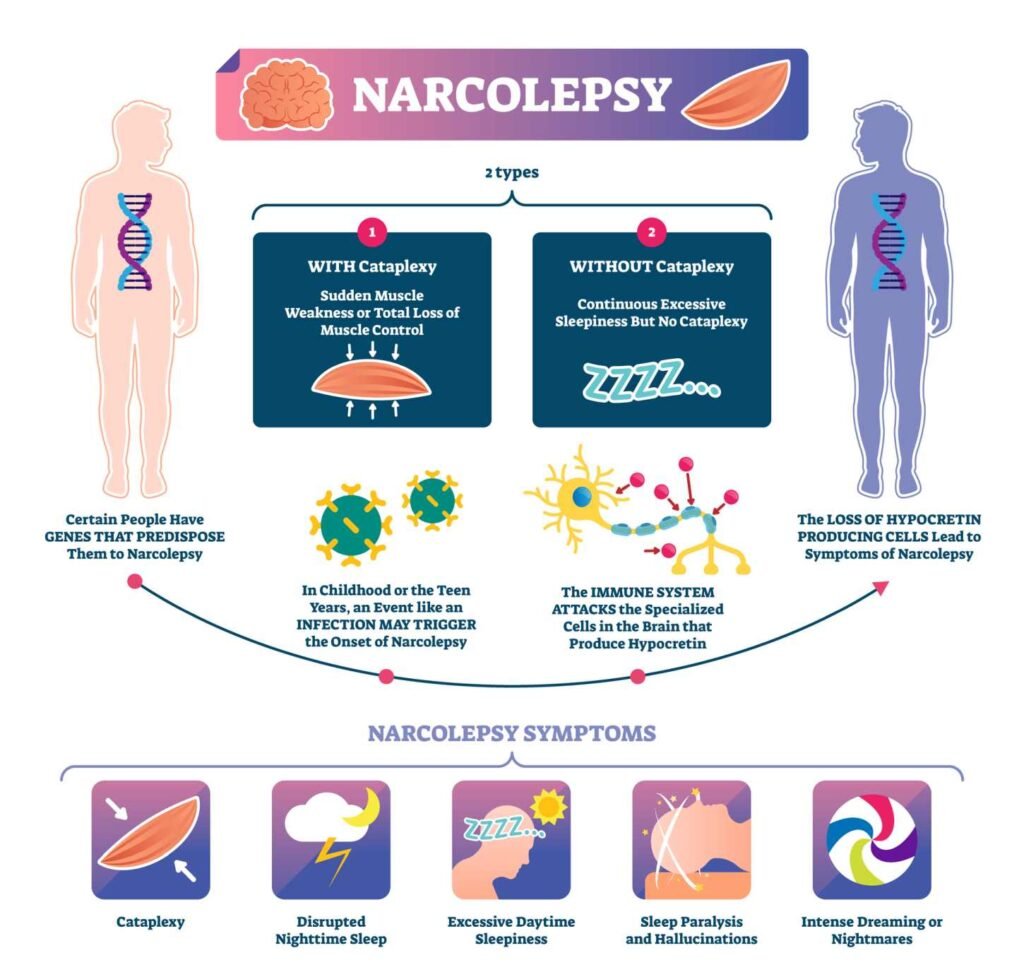Pediatric narcolepsy is a neurological disorder that affects the sleep-wake cycle of children.
Pediatric narcolepsy is a rare condition that is characterized by excessive daytime sleepiness, sudden loss of muscle tone (cataplexy), hallucinations, and sleep paralysis. The symptoms of pediatric narcolepsy can significantly impact a child’s quality of life, affecting their ability to learn, concentrate, and participate in daily activities.
In this article, I will be discussing its causes, symptoms, diagnosis, and treatment options. I hope to provide a comprehensive overview of the condition, highlighting the latest research and developments in the field. I will also explore the impact of pediatric narcolepsy on children and their families, emphasizing the importance of early diagnosis and management.

Understanding Pediatric Narcolepsy
Definition and Etiology
Pediatric narcolepsy is a type of sleep disorder that affects children and adolescents. It is a chronic sleep-wakefulness disorder that is characterized by excessive daytime sleepiness, sudden loss of muscle tone (cataplexy), hallucinations, and sleep paralysis. Narcolepsy is caused by a deficiency of hypocretin, a neurotransmitter in the central nervous system that regulates sleep and wakefulness.
The cause of pediatric narcolepsy is not yet fully understood. However, it is believed to be caused by a combination of genetic and environmental factors. Studies have shown that narcolepsy is associated with certain genes that are involved in the immune system. In addition, some environmental factors such as infections and early onset of puberty have been linked to narcolepsy in children.
Prevalence and Onset
Pediatric narcolepsy is a rare condition, affecting only about 1 in 1,000 children. The onset of narcolepsy in children is usually between the ages of 10 and 15, although it can occur at any age.
Narcolepsy in children can be difficult to diagnose, as the symptoms can be similar to other sleep disorders. However, a sleep study called a polysomnogram can help to confirm the diagnosis.
Early diagnosis and treatment of pediatric narcolepsy is important to prevent complications such as accidents and academic difficulties. Treatment may include medications such as stimulants and antidepressants, as well as lifestyle changes such as regular sleep schedules and avoiding caffeine and alcohol.
In conclusion, pediatric narcolepsy is a rare but serious sleep disorder that affects children and adolescents. Understanding the definition, etiology, prevalence, and onset of this condition is important for early diagnosis and treatment.
Symptoms and Diagnosis
Core Symptoms
Pediatric narcolepsy is characterized by excessive daytime sleepiness (EDS), which is the hallmark symptom of this disorder. Children with narcolepsy may experience daytime sleep attacks, which can occur at any time during the day, regardless of how much sleep they have had the night before. These sleep attacks can last from a few seconds to several minutes and can occur during any activity, including eating, talking, or playing.
Another core symptom of pediatric narcolepsy is cataplexy, which is a sudden loss of muscle tone triggered by strong emotions such as laughter, anger, or surprise. During a cataplectic attack, the child may experience muscle weakness, slurred speech, or even collapse to the ground.
Associated Symptoms
In addition to excessive daytime sleepiness and cataplexy, children with narcolepsy may also experience other rapid-eye-movement-related phenomena, such as hypnagogic hallucinations, sleep paralysis, and disturbed nighttime sleep.
Hypnagogic hallucinations are vivid, dream-like experiences that occur during the transition from wakefulness to sleep. Sleep paralysis is a temporary inability to move or speak during the transition from sleep to wakefulness. Disturbed nighttime sleep may include frequent awakenings, nightmares, or restless sleep.
Diagnostic Procedures
The diagnosis of pediatric narcolepsy is based on the child’s symptoms and the results of diagnostic procedures. The two main diagnostic procedures used to diagnose narcolepsy are the sleep study and the lumbar puncture.
During a sleep study, the child’s sleep patterns are monitored overnight to determine if they have narcolepsy. The sleep study measures brain waves, eye movements, muscle activity, and other physiological functions during sleep.
A lumbar puncture, also known as a spinal tap, is a procedure that involves removing a small amount of cerebrospinal fluid (CSF) from the lower back. The CSF is then analyzed for the presence of hypocretin-1, a chemical that is produced by the brain and is important in regulating wakefulness.
In addition to these diagnostic procedures, the child may also undergo a neuroimage, such as an MRI or CT scan, to rule out other conditions that may cause similar symptoms, such as a brain tumor or multiple sclerosis.
Overall, a combination of clinical evaluation and diagnostic procedures is necessary to diagnose pediatric narcolepsy accurately. Early diagnosis and treatment are essential to improving the child’s quality of life and preventing complications such as accidents, academic difficulties, and social isolation.
Treatment and Management
Pharmacological Interventions
Pharmacological treatment is an essential part of managing pediatric narcolepsy. Stimulants such as methylphenidate, modafinil, and dextroamphetamine are commonly used to treat excessive sleepiness. Sodium oxybate is another medication that is used to treat both excessive daytime sleepiness and cataplexy. Antidepressants such as clomipramine and atomoxetine may also be used to manage symptoms of narcolepsy.
It is important to note that medication management should be closely monitored by a healthcare professional. Regular follow-up appointments should be scheduled to ensure that the medication is working effectively and to monitor for any potential side effects.
Lifestyle and Behavioral Approaches
In addition to medication, lifestyle and behavioral modifications can also be helpful in managing pediatric narcolepsy. Exercise and caffeine may be used to combat excessive sleepiness. Behavioral modification techniques, such as establishing a regular sleep schedule and avoiding stimulants before bedtime, can also be helpful.
Education and mental support are also important components of managing pediatric narcolepsy. Teachers and support groups can provide assistance and accommodations for children with narcolepsy. Social interaction and studying techniques can also be helpful in managing the condition.
Support Systems
Support systems can also be an important part of managing pediatric narcolepsy. Support groups and counseling can provide emotional support and help children and their families cope with the challenges of narcolepsy. Additionally, healthcare professionals can provide education and resources to help children manage their condition and improve their quality of life.
Overall, a combination of pharmacological interventions, lifestyle and behavioral modifications, and support systems can be effective in managing pediatric narcolepsy. It is important for healthcare professionals to work closely with patients and their families to develop an individualized treatment plan that addresses their specific needs and goals.
Living with Pediatric Narcolepsy
Impact on Daily Life
Pediatric narcolepsy can have a significant impact on a child’s daily life. Children with narcolepsy may experience excessive daytime sleepiness, which can make it difficult to stay awake during school or other activities. This can lead to poor academic performance, social isolation, and a decreased quality of life.
In addition to excessive sleepiness, children with narcolepsy may also experience cataplexy, which is a sudden loss of muscle tone triggered by strong emotions such as laughter or anger. This can lead to falls and injuries, and may also affect a child’s self-esteem and social interactions.
Educational Challenges
Children with narcolepsy may face a number of educational challenges. Excessive daytime sleepiness can make it difficult to concentrate and retain information, leading to poor academic performance. Additionally, cataplexy can cause embarrassment and anxiety, which may further affect a child’s academic success.
Teachers and educational professionals should be aware of the challenges that children with narcolepsy may face, and provide appropriate accommodations and support. This may include allowing for extra time on tests, providing a quiet space for naps during the day, and working with the child and their parents to develop a plan for managing symptoms.
Early Diagnosis and Prognosis
Early diagnosis and treatment of pediatric narcolepsy is crucial for improving outcomes and quality of life. Children who are diagnosed and treated early are more likely to have better academic performance, improved social interactions, and a decreased risk of developing emotional and behavioral problems.
The prognosis for children with narcolepsy varies depending on the severity of symptoms and the effectiveness of treatment. However, with appropriate treatment and support, many children with narcolepsy are able to lead full and productive lives.
It is important for parents and healthcare professionals to be aware of the signs and symptoms of narcolepsy in children, and to seek early diagnosis and treatment when necessary.
Overall, living with pediatric narcolepsy can be challenging, but with appropriate support and management, children with narcolepsy can lead fulfilling and successful lives.
Frequently Asked Questions
What are the common symptoms of narcolepsy in children?
The common symptoms of narcolepsy in children include excessive daytime sleepiness, sudden loss of muscle tone (cataplexy), sleep paralysis, hallucinations, and disturbed nighttime sleep. Children with narcolepsy may also experience automatic behavior, which is when they continue to perform routine tasks without being aware of it.
How is narcolepsy diagnosed in pediatric patients?
Diagnosing narcolepsy in pediatric patients involves a thorough medical history, physical examination, and sleep studies. The sleep studies may include a polysomnogram (PSG) and a multiple sleep latency test (MSLT). PSG measures brain activity, eye movements, and muscle activity during sleep, while MSLT measures how quickly a person falls asleep during the day.
What treatment options are available for children with narcolepsy?
The treatment options for children with narcolepsy include stimulant medications to help with excessive daytime sleepiness, antidepressants to help with cataplexy and other symptoms, and sodium oxybate to improve nighttime sleep. Behavioral therapy and lifestyle modifications, such as regular sleep schedules and avoiding potential triggers, may also be recommended.
Can children experience cataplexy, and how does it present?
Yes, children with narcolepsy can experience cataplexy, which is a sudden loss of muscle tone triggered by strong emotions such as laughter or anger. Cataplexy can present as drooping of the face, weakness in the arms or legs, or even complete collapse.
What potential triggers should be avoided for children with narcolepsy?
Children with narcolepsy should avoid potential triggers such as alcohol, caffeine, and certain medications that can worsen symptoms. They should also maintain a regular sleep schedule, avoid napping too much during the day, and avoid activities that require prolonged attention, such as driving or operating heavy machinery.
Is it possible for children to outgrow narcolepsy, or is it a lifelong condition?
Narcolepsy is a lifelong condition, and there is currently no cure. However, with proper treatment and management, children with narcolepsy can lead normal and productive lives. It is important for parents and caregivers to work closely with healthcare providers to develop a comprehensive treatment plan that addresses the child’s specific needs.

This page contains affiliate links, which means we may earn a small commission should you buy after clicking on one, or more of those links. At no extra cost to you.



